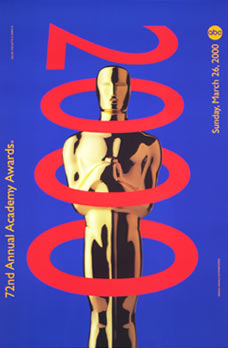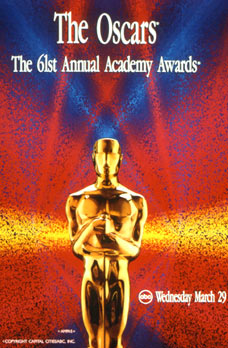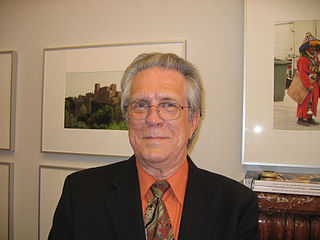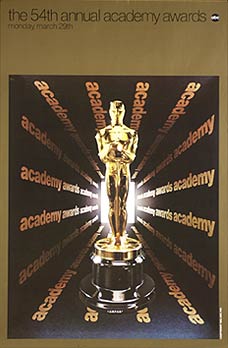Related Research Articles

The Academy Award for Best Director is an award presented annually by the Academy of Motion Picture Arts and Sciences (AMPAS). It is given in honor of a film director who has exhibited outstanding directing while working in the film industry. The award is traditionally presented by the previous year's Best Director winner.
The Academy Honorary Award – instituted in 1950 for the 23rd Academy Awards – is given annually by the Board of Governors of the Academy of Motion Picture Arts and Sciences (AMPAS). Since 2009, it has been presented at the separate annual Governors Awards rather than at the regular Academy Awards ceremony. The Honorary Award celebrates motion picture achievements that are not covered by existing Academy Awards, although prior winners of competitive Academy Awards are not excluded from receiving the Honorary Award.

The 72nd Academy Awards ceremony, presented by the Academy of Motion Picture Arts and Sciences (AMPAS), honored films released in 1999 and took place on March 26, 2000, at the Shrine Auditorium in Los Angeles, beginning at 5:30 p.m. PST / 8:30 p.m. EST. During the ceremony, the AMPAS presented Academy Awards in 23 categories. The ceremony, televised in the United States by ABC, was produced by husband-and-wife producing team Richard and Lili Fini Zanuck and was directed by Louis J. Horvitz. Actor Billy Crystal hosted the show for the seventh time. He first presided over the 62nd ceremony held in 1990 and had last hosted the 70th ceremony held in 1998. Three weeks earlier in a ceremony at the Regent Beverly Wilshire Hotel in Beverly Hills, California held on March 4, the Academy Awards for Technical Achievement were presented by host Salma Hayek.
The Scientific and Technical Awards are three different Honorary Awards that are given by the Academy of Motion Picture Arts and Sciences (AMPAS) during the annual Academy Awards season. The Awards have been presented since the 4th Academy Awards in November 1931, to recognize original developments resulting in significant improvements in motion picture production and exhibition. The Awards are presented at a formal dinner ceremony a couple weeks before the principal Academy Awards ceremony.

The 61st Academy Awards ceremony, organized by the Academy of Motion Picture Arts and Sciences (AMPAS), honored the best films of 1988, and took place on Wednesday, March 29, 1989, at the Shrine Auditorium in Los Angeles, beginning at 6:00 p.m. PST / 9:00 p.m. EST. During the ceremony, AMPAS presented Academy Awards in 23 categories. The ceremony, televised in the United States by ABC, was produced by Allan Carr and directed by Jeff Margolis. Ten days earlier, in a ceremony held at the Beverly Hills Hotel in Beverly Hills, California, the Academy Awards for Technical Achievement were presented by host Angie Dickinson.

Richard Edlund, ASC is an American visual effects artist and inventor. He was a founding member of Industrial Light & Magic, having already founded Pignose amplifiers, and later co-founded Boss Film Studios and DuMonde VFX. He has won four Academy Awards for Best Visual Effects, as well as two Special Achievement Awards, two Scientific and Technical Awards, and the Medal of Commendation. He is also a BAFTA and Emmy Award recipient.
The Gordon E. Sawyer Award is an Honorary Award given by the Academy of Motion Picture Arts and Sciences to "an individual in the motion picture industry whose technological contributions have brought credit to the industry." The award is named in honour of Gordon E. Sawyer, the former Sound Director at Samuel Goldwyn Studio and three-time Academy Award winner who claimed that a listing of past Academy Awards, arranged both chronologically and by category, represents a history of the development of motion pictures. It was first presented at the 54th Academy Awards, in April 1982. The Gordon E. Sawyer Award is voted upon and given by the Scientific and Technical Awards Committee of the Academy.

The 54th Academy Awards ceremony, organized by the Academy of Motion Picture Arts and Sciences (AMPAS), honored films released in 1981 and took place on March 29, 1982, at the Dorothy Chandler Pavilion in Los Angeles beginning at 6:00 p.m. PST / 9:00 p.m. EST. During the ceremony, AMPAS presented Academy Awards in 22 categories. The ceremony, televised in the United States by ABC, was produced by Howard W. Koch and directed by Marty Pasetta. Comedian and talk show host Johnny Carson hosted the show for the third consecutive time. One week earlier, in a ceremony held at The Beverly Hilton in Beverly Hills, California, on March 21, the Academy Scientific and Technical Awards were presented by hosts Lloyd Bridges and Fay Kanin.
Linwood G. Dunn, A.S.C. was an American pioneer of visual special effects in motion pictures and an inventor of related technology. Dunn worked on many films and television series, including the original 1933 King Kong (1933), Citizen Kane (1941), and Star Trek (1966–69).
The 22nd Academy Awards were held on March 23, 1950, at the RKO Pantages Theatre, honoring the films in 1949.
The 21st Academy Awards were held on March 24, 1949, honoring the films of 1948. The ceremony was moved from the Shrine Auditorium to the Academy's own theater, primarily because the major Hollywood studios had withdrawn their financial support in order to address rumors that they had been trying to influence voters. This year marked the first time a non-Hollywood production won Best Picture, and the first time an individual (Olivier) directed himself in an Oscar-winning performance.
The Academy Award for Best Original Song is one of the awards given annually to people working in the motion picture industry by the Academy of Motion Picture Arts and Sciences (AMPAS). It is presented to the songwriters who have composed the best original song written specifically for a film. The performers of a song are not credited with the Academy Award unless they contributed either to music, lyrics, or both in their own right. The songs that are nominated for this award are typically performed during the ceremony and before this award is presented.
John Morgan Eargle was an Oscar- and Grammy-winning audio engineer and a musician. He was the Chief Engineer for Delos International, author of seminal textbooks on audio, a consultant for 31 years at JBL, and past president and fellow of the Audio Engineering Society.

The Academy Award for Best Original Screenplay is the Academy Award for the best screenplay not based upon previously published material. It was created in 1940 as a separate writing award from the Academy Award for Best Story. Beginning with the Oscars for 1957, the two categories were combined to honor only the screenplay.
Takuo Miyagishima was a Japanese-American design engineer who worked for Panavision. He was responsible for many of the company's innovations in motion picture photography and projection.
Edmund DiGiulio was an American technical innovator who founded Cinema Products Corporation that developed the Steadicam, CP-16, and won multiple Academy Scientific and Technical Awards as well as the Gordon E. Sawyer Award for his contributions to motion picture technology in 2001.
Don Hall is an American sound editor. He won two Primetime Emmy Awards and was nominated for three more in the category Outstanding Sound Editing for his work on the television program Voyage to the Bottom of the Sea and also the television films Tribes, Eleanor and Franklin and Standing Tall. Hall was also honored an Academy Award for the John A. Bonner Medal of Commendation.
References
- 1 2 3 "John A. Bonner Medal of Commendation". Academy of Motion Picture Arts and Sciences - John A. Bonner Medal of Commendation. Academy of Motion Picture Arts and Sciences. Retrieved 23 February 2015.